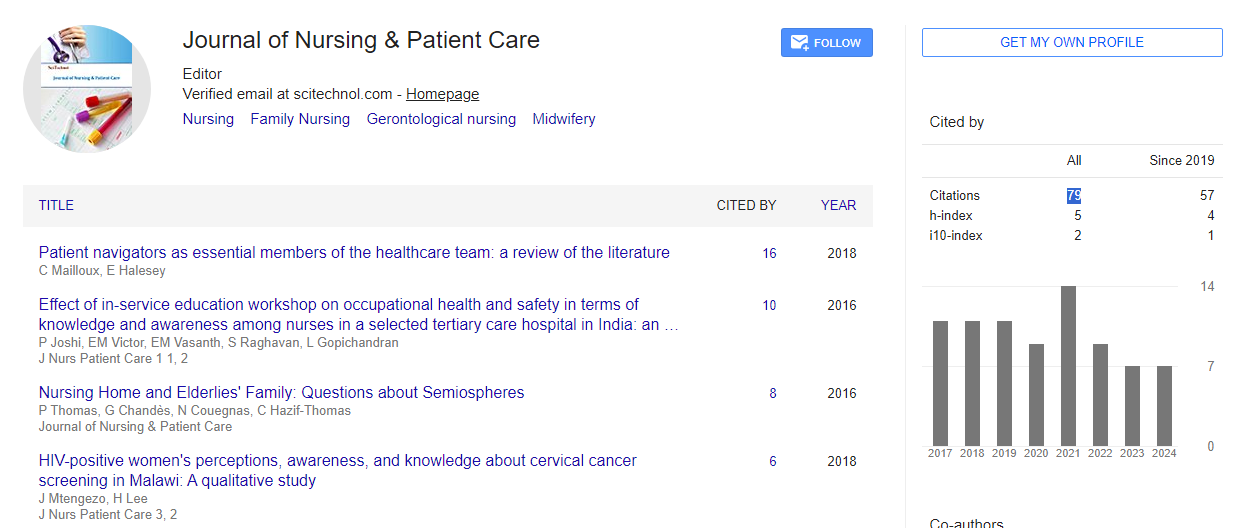Commentary, J Nurs Patient Care Vol: 9 Issue: 2
Neonatal Care: Protocols and Practices for High-Risk Infants
Canny Zhany*
1Department of Pediatrics, Duke University School of Medicine, Durham, USA
*Corresponding Author: Canny Zhany,
Department of Pediatrics, Duke University
School of Medicine, Durham, USA
E-mail: zhanycan@y.edu
Received date: 28 May, 2024, Manuscript No. JNPC-24-140260;
Editor assigned date: 30 May, 2024, PreQC No. JNPC-24-140260 (PQ);
Reviewed date: 13 June, 2024, QC No. JNPC-24-140260;
Revised date: 21 June, 2024, Manuscript No. JNPC-24-140260 (R);
Published date: 28 June, 2024, DOI: 10.4172/2573-4571.1000061.
Citation: Zhany C (2024) Neonatal Care: Protocols and Practices for High-Risk Infants. J Nurs Patient Care 9:2.
Description
Neonatal care for high-risk infants requires specialized protocols and practices to address their unique medical needs and ensure optimal outcomes. High-risk infants encompass a diverse group, including premature babies, those with congenital anomalies, and infants born with medical complications. Effective neonatal care involves a multidisciplinary approach, advanced medical technologies, and a supportive environment that prioritizes the delicate health and development of these vulnerable newborns.
High-risk infants require intensive monitoring and specialized interventions due to their increased susceptibility to complications. These infants may be born prematurely (before 37 weeks gestation), have low birth weight, or exhibit conditions such as congenital heart defects, respiratory distress syndrome, or neurological disorders. Identifying risk factors early and initiating appropriate interventions are crucial for improving outcomes and reducing long-term health challenges.
Effective neonatal care for high-risk infants relies on a multidisciplinary team comprising neonatologists, pediatric specialists, nurses, respiratory therapists, nutritionists, and social workers. This collaborative approach ensures comprehensive assessment, timely interventions, and personalized care plans tailored to each infant’s specific needs.
Neonatologists specialize in the care of newborns, particularly those requiring intensive care due to prematurity or medical complexities. They oversee the medical management, coordinate diagnostic evaluations, and provide expert guidance on treatment decisions. Specialists such as pediatric cardiologists, neurologists, and surgeons may be consulted to address specific medical conditions or congenital anomalies affecting the infant.
Neonatal nurses plays an important role in monitoring vital signs, administering medications, providing nutritional support, and implementing care protocols. They also educate parents on infant care practices and support bonding and breastfeeding initiatives. Respiratory therapists manage ventilator support, oxygen therapy, and respiratory assessments to optimize lung function in infants with respiratory distress or chronic lung disease. Nutritionists develop specialized feeding plans tailored to the infant’s nutritional needs, ensuring optimal growth and development despite feeding challenges common in high-risk infants.
Social workers provide emotional support to families, coordinate discharge planning, and connect families with community resources and support networks. Many high-risk infants experience respiratory challenges, necessitating advanced respiratory support strategies. These may include non-invasive ventilation (such as CPAP or BiPAP) or invasive mechanical ventilation for severe respiratory distress syndrome or congenital anomalies affecting lung function. Infants with congenital heart defects or cardiovascular instability require continuous monitoring and may need interventions such as medication administration, surgical correction, or cardiac catheterization procedures.
Maintaining thermal stability is critical for high-risk infants, who are susceptible to hypothermia or hyperthermia. Incubators or radiant warmers are used to regulate body temperature, minimizing energy expenditure and preventing complications. Nutritional support is tailored to the infant’s gestational age, growth trajectory, and feeding capabilities. For premature infants or those with feeding difficulties, enteral nutrition through nasogastric or gastric tubes is initiated gradually, transitioning to breastfeeding or bottle feeding as tolerated. High-risk infants have immature immune systems, making them vulnerable to infections. Strict infection control practices, including hand hygiene, aseptic techniques during procedures, and monitoring for early signs of sepsis, are essential to reduce the risk of nosocomial infections.
Monitoring neurodevelopmental milestones and providing early intervention services for infants at risk of developmental delays are integral to optimizing long-term outcomes. This may involve neuroimaging studies, developmental assessments, and referral to early intervention programs. Incorporating families into the care team promotes bonding, supports parental involvement in decision-making, and enhances caregiving consistency post-discharge. Parental presence during rounds, skin-to-skin contact (kangaroo care), and breastfeeding support contribute to improved infant outcomes and parental satisfaction.
Conclusion
Neonatal care for high-risk infants requires a comprehensive and integrated approach that addresses medical, developmental, and family needs. By implementing evidence-based protocols, leveraging multidisciplinary expertise, and embracing technological innovations, healthcare providers can optimize outcomes and support the long-term health and well-being of these vulnerable newborns. Continued research, advocacy for healthcare equity, and ongoing collaboration among healthcare professionals are essential to advancing neonatal care and improving outcomes for all high-risk infants.
 Spanish
Spanish  Chinese
Chinese  Russian
Russian  German
German  French
French  Japanese
Japanese  Portuguese
Portuguese  Hindi
Hindi 